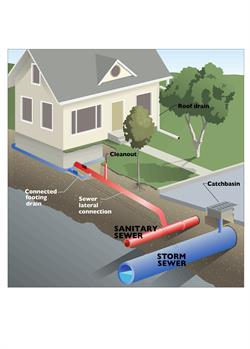
Over many decades, many structures in Ann Arbor were built with footing drains, pipes installed around or beneath a structure to collect then direct stormwater away. Unfortunately these were then connected directly to the sanitary sewer system, therefore mixing storm and sewer water. Later, code even allowed the use of sump pumps, or similar systems, to pump water from footing drains into the sewer as well.
What's the problem with my footing drain connecting to the sewer?
Large storms or heavy rain can cause a massive flow of stormwater, sometimes 10-20 times normal, into sanitary sewer pipes, through these connected footing drains.
The extra flow can temporarily exceed the system’s capacity, which can result in overwhelming the sewer treatment plant and/or basement backups.
A number of times during the 1980s, 1990s and early 2000s, large rainstorms caused the sanitary sewer system to exceed capacity, causing sewage to back up in homes in some neighborhoods.
Development, such as the construction of new buildings and homes, increases the burden on the sanitary sewer system.
What can we do to fix the problem?
Removing a building’s connected footing drains through the Developer Offset Mitigation (DOM) program can:
- Reduce the amount of stormwater entering the sanitary sewer system
- Reduce overall flow in the sanitary system improves it's capacity
- Reduce the chance of sanitary sewer overflows and basement backups
- Reduce unnecessary treatment of stormwater
The City also has a set of program guidelines (PDF) for developers engage in this program.

